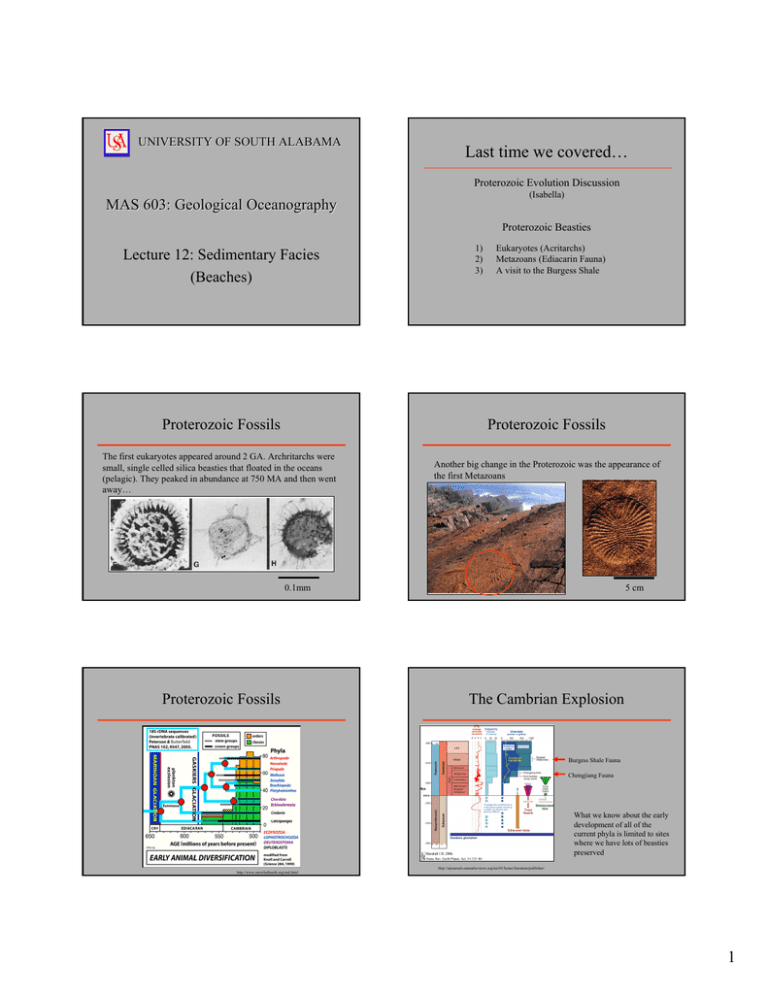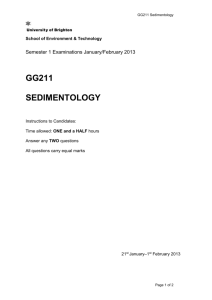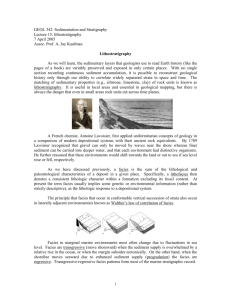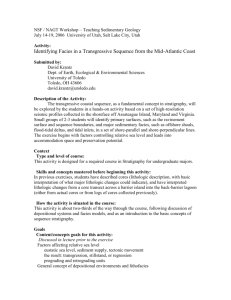Last time we covered…
advertisement

UNIVERSITY OF SOUTH ALABAMA Last time we covered… Proterozoic Evolution Discussion (Isabella) MAS 603: Geological Oceanography Proterozoic Beasties Lecture 12: Sedimentary Facies (Beaches) 1) 2) 3) Eukaryotes (Acritarchs) Metazoans (Ediacarin Fauna) A visit to the Burgess Shale Proterozoic Fossils Proterozoic Fossils The first eukaryotes appeared around 2 GA. Archritarchs were small, single celled silica beasties that floated in the oceans (pelagic). They peaked in abundance at 750 MA and then went away… Another big change in the Proterozoic was the appearance of the first Metazoans 0.1mm Proterozoic Fossils 5 cm The Cambrian Explosion Burgess Shale Fauna Chengjiang Fauna What we know about the early development of all of the current phyla is limited to sites where we have lots of beasties preserved http://www.snowballearth.org/end.html http://arjournals.annualreviews.org/na101/home/literatum/publisher/ 1 The Burgess Shale Today’s Agenda Sedimentary Facies 1) 2) 3) Facies versus depositional environments Walther’s Law Beaches http://home.earthlink.net/~airdpacoima/sitebuildercontent/sitebuilderpictures/burgess__s.jpg Sedimentary Facies There are literally dozens of different depositional environments that cover every imaginable marine and non-marine situation. Sedimentary Facies And in most cases, there are multiple varieties of each basic environment of deposition. For example, rivers come in at least 3 “flavors”: http://earthsci.org/mineral/rockmin/sed/clastics.gif 1) Meandering 2) Braided 3) Anastimosing Sedimentary Facies Ultimately, depositional environments are the sum of their various components and each of those components are distinguished from one another of the basis of geological characteristics. The components that collectively define depositional environments are called sedimentary facies (or just facies). Sedimentary Facies Defining characteristics for facies include: Grain size Lithology Mineralogy Paleontology Sedimentary and biogenic structures Palaeocurrent orientations Obvious sedimentary trends Bedding (Bed thickness) Lamination Bedding contacts Lateral variations Anything else that you can think of http://www.kgs.ku.edu/PRS/publication/ofr2003-82/gif/figure1_06.gif 2 Facies modeling is best done back at your lab/office where you can consider your data… …and drink a few beers to really help you think about your data… Facies Modeling Prograding Open Beach Facies Modeling …and interpret what your data are implying Sedimentary Facies Facies can, and will, repeat vertically through a sedimentary sequence… Sedimentary Facies Facies can, and will, repeat vertically through a sedimentary sequence…but may vary in character as a result of environmental and/or evolutionary change through time shoreface (5m) swash zone (0m) shoreface (5m) e.g., fossil content. offshore (10m) Sedimentary Facies Walther’s Law Facies may also change laterally through a deposit as a result of changing environments with distance at the same time. 3 Walther’s Law Named after Johannes Walther (18601937), a German geologist, who in 1894, noted a fundamental relationship between the vertical and lateral distribution of facies. Walther’s Law Sedimentary environments that started out side-by-side will end up overlapping one another over time due to transgressions and regressions. Walther’s Law Sedimentary environments that started out side-by-side will end up overlapping one another over time due to transgressions and regressions. The result is a vertical sequence of beds. The vertical sequence of facies mirrors the original lateral distribution of sedimentary environments. Walther’s Law Sedimentary environments that started out side-by-side will end up overlapping one another over time due to transgressions and regressions. Walther’s Law Walther’s Law But… And… • Walther's Law can only apply to sections without unconformities. • Walther's Law can only apply to a section without subdividing diachronous boundaries [e.g., transgressive surfaces (TS), maximum flooding surfaces (mfs) etc.] Tan and white layers of Mesozoic Era Period Pio Nono Formation in Georgia's Coastal Plain Province. http://itc.gsw.edu/faculty/daskren/fallline.htm Aside 4 Sequence Stratigraphy Sequence Stratigraphy First utilized by the petroleum industry to interpret depositional surfaces on seismic sections. Now used by all geologists to explain vertical and lateral changes in sediment rock distribution. First utilized by the petroleum industry to interpret depositional surfaces on seismic sections. Now used by all geologists to explain vertical and lateral changes in sediment rock distribution. http://strata.geol.sc.edu/exerices/seismic/07SeqNo_LST_TST_HST.jpg http://strata.geol.sc.edu/exerices/seismic/07SeqNo_LST_TST_HST.jpg Sediment is deposited in distinct systems tracts. Sequence Stratigraphy Sequence Stratigraphy First utilized by the petroleum industry to interpret depositional surfaces on seismic sections. Now used by all geologists to explain vertical and lateral changes in sediment rock distribution. http://strata.geol.sc.edu/exerices/seismic/07SeqNo_LST_TST_HST.jpg The 3 controls on system tract architecture are: 1) sea level position, 2) sediment input, 3) accommodation space. Sedimentary Environments: Beaches Factors promoting beach development Beach profiles Beach facies & sedimentary sections Ultimately, sedimentary “packages” are bounded by specific surfaces (reflectors in the seismic lines), and this is where/when Walther’s Law breaks down Factors controlling beach development Steady supply of sand to the shoreline, by river, delta or longshore drift Wave dominated setting (medium to high wave energy is best; low tidal energy necessary) Stable, low gradient coastal plan and continental shelf gradient 32,000 km of shoreline meet these requirements; best studied beaches are along the US eastern and Gulf coasts 5 Wave action Wave action Wind Orbicular motion Wave base From Komar, P.D., 1998. Beach Processes and Sedimentation. Prentice Hall, New Jersey, 544p. From Komar, P.D., 1998. Beach Processes and Sedimentation. Prentice Hall, New Jersey, 544p. Overall beach dynamics Longshore drift From Walker, R.G. and James, N.P. (1992). Facies Models: Response to Sea Level Change. Geological Association of Canada, 409p. From Walker, R.G. and James, N.P. (1992). Facies Models: Response to Sea Level Change. Geological Association of Canada, 409p. Hydrodynamic zones Overall beach dynamics Sedimentary Facies From Blatt, H, Middleton, G. and Murray, R., 1980. Origin of Sedimentary Rocks. Prentice Hill, 782 p. From Komar, P.D., 1998. Beach Processes and Sedimentation. Prentice Hall, New Jersey, 544p. 6 From Walker, R.G. and James, N.P. (1992). Facies Models: Response to Sea Level Change. Geological Association of Canada, 409p. Beach Facies From Walker, R.G. and James, N.P. (1992). Facies Models: Response to Sea Level Change. Geological Association of Canada, 409p. Beach Facies Facies distribution on beaches is a ballet between shoreline advance (progradation) and retreat. Beach change = construction-destruction Beach Facies & Structures From Walker, R.G. and James, N.P. (1992). Facies Models: Response to Sea Level Change. Geological Association of Canada, 409p. Beach Facies Galveston Island; a prograding beach From Walker, R.G. and James, N.P. (1992). Facies Models: Response to Sea Level Change. Geological Association of Canada, 409p. Beach Facies From Walker, R.G. and James, N.P. (1992). Facies Models: Response to Sea Level Change. Geological Association of Canada, 409p. Sea level as a control on beach development From Walker, R.G. and James, N.P. (1992). Facies Models: Response to Sea Level Change. Geological Association of Canada, 409p. 7 Next Time 1. Monday: Shelf Sedimentation 2. Wednesday: Submarine Fans 8




